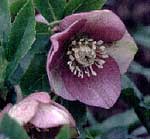
 |
Helleborus orientalis Lamarck
This is the species from which most of the garden hybrids have been developed, either by selection or hybridisation. Its distribution is quite distinct from that of other species, stretching as it does from Greece to the Caucasus mountains, and it is a variable species both in the wild and in gardens. Over the years a very large number of forms have been given names from specific to varietal rank but only three subspecies are now recognised botanically although many other names are still sometimes found in gardens and in literature.
General description
An evergreen perennial reaching up to 18in (45cm) in height. The pedately divided foliage usually has the central leaflet undivided, the remainder being divided to give from seven to eleven segments. The leaves can be up to 18in (45cm) in width and the individual segments are usually roughly elliptical in shape, or they may be slightly broader towards the apex and are about 7in (17.5cm) long and 3in (7.5cm) at their widest. They are coarsely toothed. The leaves are tough, leathery and generally without hairs.
The flowering stem may be green or speckled, especially towards the base, and usually carries up to seven unscented flowers which are 2-3in (4.5-7cm) across in the wild although garden plants may have flowers up to 4in (10cm) across making them the largest flowers in this section. The flowers are usually at least slightly nodding, eventually opening almost flat and may be white, greenish or creamy in colour or red-tinted and may be spotted or streaked in red; the nectaries are green or red-tinted. The carpels are not joined at the base.
This species is divided into three subspecies.
Helleborus orientalis subsp. orientalis
The flowers of this subspecies are generally white with a varying amount of cream or green shading with two petals often smaller and greener than the other three; the nectaries are green.
There are two recent, fairly typical collections of this subspecies in the National Collection. One was collected by Jeremy Wood above the Black Sea coast of Turkey. The flower buds are greeny yellow, while the mature flowers are green at the base, changing to a semi-translucent white at the edges; there are greenish stripes on the backs and slightly yellower stripes inside the flowers, which are about 13/4-2in (4.5-5.5cm) across. There are twelve flowers per stem. This plant was found near Trabzon, between Ordu and Ulubey and was growing with Cyclamen coum, Galanthus fosteri, Primula vulgaris and P. vulgaris subsp. sibthorpii.
The second plant was collected by Jim Archibald under the number JCA 562.400 in the Bolu hills near Abant Golu in moist deciduous and evergreen woods. It has slightly larger flowers, up to 21/2in (6cm), creamy in bud opening mostly white in colour with green streaking inside and out and an area of solid green at the base of the petals; mature flowers develop a creamier shade at tips of petals. Roy Lancaster reports Fritillaria pontica and Orchis palustris as companions in meadows in the same area to the east of Lake Abant.
Many visitors to the area report that colonies are very even in flower colour, with each flower a mixture of white, cream and green.
Natural distribution and habitat
In the wild the distribution of this subspecies stretches from north west Turkey, or possibly the north east corner of Greece, then right along the Black Sea coast of Turkey and into the central and western Caucasus mountains. This and the other two subspecies grow in similar habitats, their ease of cultivation in gardens being a reflection of the variety of habitats in which they grow. They are found in both deciduous and coniferous woods, hazel coppice, scrub, rhododendron thickets, clearings and on roadsides. At higher altitudes they grow in open grassy places. All three subspecies prefer limestone soils although they tend to grow on deeper soils than other species often a deep loam or leaf soil.
In beech and Picea woods and in hazel coppice on the way up to the Zigana Pass in the Pontus Mountains south of Trabzon this subspecies grows with Cornus mas, Cyclamen coum, Daphne pontica, Fritillaria pontica, Galanthus plicatus, Gentiana asclepiadea, Paeonia aretiana, Primula vulgaris, P. vulgaris subsp. sibthorpii, Rhododendron luteum, R. ponticum, Trachystemon orientale and Vaccinium arctostaphylos together with other gentians, lilies and primulas. Paul Furse found it in the same general area with blue and white Aquilegia glandulosa var. jucunda and marsh orchids.
Near the Russian Black Sea coast at Dagomys, a tea growing district of Sochi, Erich Pohle found white flowered plants, sometimes with very tiny red spots, growing with large quantities of Cyclamen coum subsp. caucasicum together with Galanthus caucasicus and Paeonia mlokosevitchii. 100 miles further south near Pitsunda in Georgia he found some very large plants, 24-28in (60-70cm) high. These were creamy white inside and cream with a light brown tint on the inside.
Helleborus orientalis subsp. abchasicus
Helleborus orientalis subsp. abchasicus (A. Braun) B. Mathew
The flowers set this subspecies apart, for they are strikingly red-tinted and may also be spotted. The nectaries may also be purple, although sometimes only at the tips or in streaks.
Natural distribution and habitat
Information on the distribution of this subspecies is rather sparse but it seems to be restricted to the western end of the Caucasus mountains.
Recently, wild collected material has been received from Erich Pohle collected near Sukhumi in Georgia. Many opf the plants in this area have mainly greenish white flowers have a strong cast of dense red-purple speckles and mainly green nectaries though some have pale red flowers, greening a little towards the base, and with purple nectaries.
Surpisingly, a plant may fit here is naturalised in a beech wood in Gloucestershire, but the plant in question is probably simply a reddish garden hybrid.
This is the least common subspecies in gardens except in its early flowering form known for many years as H. atrorubens Hort., 'Atrorubens' or "H. atrorubens of gardens" (see page 000).
Helleborus orientalis Lamarck. subsp. guttatus
Helleborus orientalis Lamarck. subsp. guttatus (A. Braun & Sauer) B. Mathew
This is a parent of many of the most popular garden hellebores, clearly distinguished by its pale, often green-flushed, white flowers spotted to a varying degree with red or purple. Again, two petals may be smaller and more green than the other three, a feature inherited by many, less satisfactory, garden hybrids.
On the market in Sochi, on the Black Sea coast just into Russia north of the border with Georgia, Eric Pohle found cut flowers of this plant on sale which were pure white with large sparkling red dots though the flowers themselves were thought to have come from across the border.
Natural distribution and habitat
As with subsp. abchasicus, information on the precise distribution of this subspecies is thin but it seems concentrated in the central and eastern Caucasus.
Roy Lancaster gives an account in Plantsmen on Plants of finding this plant on the wooded limestone slopes above the Black Sea resort of Sukhumi in 1979: 'We found Helleborus guttatus, leaves and fruit only, and Cyclamen abschasicucm (now C. coum subsp. caucasicum) is plentiful in season. As in other areas of the Caucasus the large heart-shaped leaves of Trachystemon orientale carpeted the ground in places and only marginally less common were Epimedium colchicum and Omphalodes cappadocica... The white bells of Campanula alliarifolia always charm me, carried as they are in one-sided racemes. It was frequent here and often associated with the evergreen clumps of two butcher's brooms - Ruscus ponticus and R. colchicus. The first is merely a narrow leaved R. aculeatus but the second is a distinct and localised species now represented though rarely in cultivation.'
It is perhaps worth saying here that in one tract of country stretching straddling the border between Russia and Georgia and of about 100 miles north to south, Erich Pohle seems to have found colonies or seen plants of all three subspecies of H. orientalis. Further field work is clearly required before the position can be clarified.
Cultivation
The cultivation of this species presents few particular problems and the regime described in Chapter Three (page 00) is suitable.
In gardens
The name "Guttatus" is one used frequently in gardens, usually for any plants with spots but sometimes restricted to those with a cluster of spots towards the base of the petals. Spotting is a characteristic which can increase with the maturity of the plant and then become more consistent as the plant matures further, though even well established plants can vary from year to year especially after division or a difficult season.
Cultivated forms
A very large number of cultivated selections and hybrids have been named and these are described iunder Orientalis Hybrids . Although the dark colours derive from H. torquatus and the yellows from H. cyclophyllus, H. multifidus and H. odorus in all cases the original crosses were with forms of H. orientalis and both the pure and spotted whites are derived entirely from H. orientalis.
 |
|
|
|
|